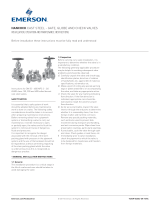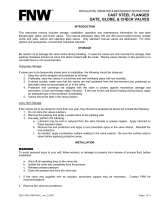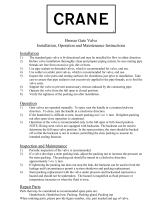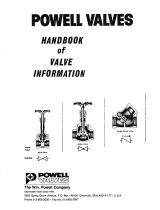Page is loading ...

HANCOCK FORGED STEEL - GATE, GLOBE AND CHECK VALVES
INSTALLATION, OPERATION AND MAINTENANCE INSTRUCTIONS
SAFETY NOTICE
It is essential that a safe system of work
should be adopted before any maintenance
work is done on a valve. The following safety
considerations should be taken in to account
when preparing maintenance instructions.
Before removing valves from a pipework
system or dismantling a valve to carry out
maintenance, it will be necessary to open,
or partially open, the valves and to flush the
system to remove all traces of dangerous
fluidsand pressures.
It is important to recognize the danger
associated with the removal of the stem
packing gland with pressure in the pipework
system and the use of the backseat should not
be regarded as a device permitting repacking
of the stem packing gland whilst the valve
is under pressure as this is recognized as
dangerous practice.
1 GENERAL INSTALLATION INSTRUCTIONS
1.1 General
The installation procedure is a critical stage in
the life of a valve and care should be taken to
avoid damaging the valve.
1.2 Safety precautions
a) Hancock Forged Steel valves are shipped
with the packing gland nuts only hand tight.
Always tighten the packing gland nuts
before pressurizing a valve.
b) Do not attempt to remove the packing gland
nuts while the valve is under pressure.
Before installation these instructions must be fully read and understood
VCIOM-02505-EN 15/05
c) Do not attempt to eliminate bonnet gasket
leakage by tightening the bonnet bolts
whilethe valve is under pressure.
d) The bonnet should not be removed while
thevalve is under pressure.
e) Do not attempt to remove the thread
bushing while the valve is under pressure.
f) No alteration and/or modification should
be ma
de to any Hancock valve, except as
sanctioned and/or authorized by Emerson.
g)
h)
Any modification of a Hancock valve,
toaccept a gear operator, motor operator
or
pneumatic/hydraulic actuator should
be accomplished using only those designs
sanctioned and/or authorized by Emerson.
Never install, or attempt to use, any valve
that is not properly identified as to its
material and pressure class.
1.3 Screwed valves - joint assembly
Threaded pipe joints depend on a good fit
between the external and internal pipe threads
for tight sealing. Usually, a compatible soft
or viscous material is used between the
assembled threads to assist in ensuring a
leak-free seal. The following installation
practices are recommended:
a) Check the threads on both the valve and
the mating pipe for correct thread form and
cleanliness. Be alert for any indication of an
impact that might have deformed the thread
either out-of-round or by a local indentation.
Be sure no chips or grit are present.
b) Note the internal length of the threads in
the valve ends and the proximity of the valve
internal seat to make sure the pipe end will
not hit the seat when assembled. If there
appears to be a possibility of a problem,
carefully check the pipe end thread to make
sure there is no extended straight portion
beyond the standard tapered section.
c) Apply an appropriate thread tape or thread
compound to the external pipe threads
except when dry seal threading is specified.
Avoid getting the thread tape or thread
compound into the internal flow area.
d) Use care to align the threads at the point
of assembly. Tapered pipe threads are
inherently a loose fit at entry. Substantial
wrenching force should not be applied
until it is apparent that the threads are
properlyengaged.
NOTE
Because there is no clear limit on the torque
that may be developed in a tapered thread joint,
it is possible to damage the valves or piping by
applying excessive twisting forces through the
body of the valve. If at all possible a wrench should
be used on the same end of the valve to which the
pipe is being threaded into. This way the torque
load will not be applied throughout the valve body.
f) Repeat the process at the second valve end.
Again, apply the wrench at end of the valve
to which the pipe is being assembled.
Instructions for DN 15 - 50 (NPS ½ - 2)
ASMEclass 800 and 1500 forged steel valves.
e) Assemble the joint wrench-tight. The
wrench on the valve should be on the valve
end into which the pipe is being threaded.
Emerson.com/FinalControl © 2017 Emerson. All rights reserved.

2
3
5
1
8
4
6
2
7
HANCOCK FORGED STEEL - GATE, GLOBE AND CHECK VALVES
INSTALLATION, OPERATION AND MAINTENANCE INSTRUCTIONS
1.4 Flanged joint assembly
Pipe flanged joints depend on compressive
deformation of gasket material between the
facing flange surfaces for tight sealing.
In order to obtain satisfactory flange joints,
thefollowing points should be observed.
a) Check the mating flange facings (both valve
and pipework flanges) for correct gasket
contact face, surface finish and condition.
b) Check the bolting for proper size, length
and material. A carbon steel bolt on a high
temperature flange joint can result in early
joint failure.
c) Check the gasket material. For flange joints
using low strength bolting, such as may be
provided for iron flanges, metal gaskets
(flat, grooved, jacketed, corrugated or spiral
wound) should not be used.
d) Check the gaskets for freedom from defects
or damage.
e) Take care to provide good alignment of
the flanges being assembled. Use suitable
lubricants on bolt threads. In assembly,
sequence bolt tightening to make the initial
contact of flanges and gaskets as flat and
parallel as possible. Tighten gradually and
uniformly to avoid the tendency to twist one
flange relative to other.
f) Parallel alignment of flanges is especially
important in the case of the assembly of a
valve in to an existing system. It should be
recognized in such instances that, if the
flanges are not parallel, it will be necessary
to introduce bending to make the flange
joint tight. Simply, forcing the flanges
together with the bolting may bend the pipe,
or it may bend the valve.
g) All bolts shall be tightened in a star
pattern as shown below to ensure uniform
gasketloading.
BOLT TORQUING SEQUENCE
1-2-3-4-5-6-7-8
1.6 Testing and adjustment
Following installation, all valves should
be operated to check that they still
functioncorrectly.
On new pipework systems, system pressure
testing and commissioning follow after
installation when various checks are made.
Valves are usually supplied in the lubricated
condition, but it is recommended that checks
are made to ensure that this is still intact,
particularly after the application of heat
(e.g.welding operation).
A first observation can be made by actuating
the valve through an open-close or
close-opencycle.
It is common practice, after installation of
pipework systems, to clean the system by
blowing with a gas or steam or flushing with
a liquid to remove debris and / or internal
protective films and coatings. It should be
recognized that valve cavities may form a
natural trap in a pipework system and material
not dissolved in or carried out by the flushing
fluid may settle in such cavities and adversely
affect valve operation. Also, abrasive material
carried by a high velocity fluid stream may
cause serious damage to seating surfaces.
Do not subject the valve to pressures/
temperature testing in excess of its
statedlimits.
1.5 Butt weld joint assembly
All welding should comply with the appropriate
pipe system or application code. Welded
joints, properly made, provide a structural and
metallurgical continuity between the pipe and
the valve body.
Butt welds require full penetration and
thickness at least equal to that of the pipes.
If a pipe of high strength alloy is welded to a
valve with body material of lower mechanical
strength, the weld should taper to a
compensating greater thickness at the valve
end, or the valve should have a matching high
strength welded-on extension.
Particular care is necessary when welding
valves into the line. Considerable distortion,
resulting in line strains, may occur if valves
are not welded into the line with care, where
required, the weld properly stress relieved,
but it is necessary to ensure that such stress
relieving does not result in valve components,
particularly the seating being subjected to
unacceptable temperatures.
It is recommended that the valves are not
installed in the pipework at points of high
bending moments, as this can adversely
affectthe seating performances.
2 GATE VALVES
2.1 Installation and operation
2.1.1 Prior to installation
Valves not required for immediate use should
be stored under clean conditions to reduce the
risk of foreign matter entering the valve during
unpacking. If the valves are unpacked for
checking purposes, they should be immediately
re-packed until required for use.
Protection caps fitted to inlet and outlet
connections must be removed, but not until
immediately prior to installation.
Seating faces should be wiped clean with a
drycloth before commencing installation.

3
16
17
18
15
14
13
12
11
10
9
8
7
6
5
4
3
2
1
HANCOCK FORGED STEEL - GATE, GLOBE AND CHECK VALVES
INSTALLATION, OPERATION AND MAINTENANCE INSTRUCTIONS
PARTS LIST
No. Description
1 Body
2 Seat
3 Wedge
4 Stem
5 Gasket
6 Bonnet
7 Bolt
8 Pin
9 Gland
10 Gland eyebolt
11 Gland flange
12 Hex nut
13 Stem nut
14 Locking nut
15 Nameplate
16 Handwheel
17 Lubricating gasket
18 Packing
120° stagger
of joints
Packing
2.4 Disassembly
A. Body/bonnet
a) Never attempt to disassemble a valve
bonnet if there is pressure in the line.
b) Before beginning disassembly, open the
valve approximately half way. Remove
the bonnet bolts using standard socket
wrenches. The bonnet assembly may then
be lifted off the body. Remove the bonnet
gasket from the body, taking care not to
damage the gasket seating surfaces.
B. Bonnet
a) The bonnet assembly may now be
disassembled.
b) Remove the two packing gland nuts.
Free the packing gland from the
packingchamber.
c) Remove handwheel from stem.
d) Remove the stem assembly by screwing
it out of the yoke nut and forcing it down
through the stuffing box. Rotating the
stem while forcing will help ease the
stem through the stuffing box.
e) The packing gland and gland flange can
now be removed.
f) Remove packing, taking care not to
damage the stuffing box.
2.3 Packing adjustment
a) All Hancock forged steel gate and globe
valves are supplied with flexible graphite
and carbon fiber.
b) Do not repack valve while valve is in service.
c) When the valve has been placed in service
and has been brought up to temperature,
the packing should be checked for leakage.
Close the valve ½ turn and check the
packing for leakage. If leakage occurs,
adjust the packing gland.
d) To adjust the packing gland, run the nuts
down every ½ turn on all bolts. Turn the
handwheel back and forth ½ turn after each
adjustment. Again, check for leakage. If
binding of the stem occurs and the leakage
has stopped, loosen the packing nuts ¼
turn. Check the stem for binding and check
for leakage. The object is to tighten the
packing a minimum amount to prevent
leakage, while producing a minimum
amount of stem binding.
2.1.2 Installation
Valves are suitable for flow in either direction,
but they should be fitted in either horizontal
pipelines with the stem upright or vertical
lines. Other positions can be detrimental to the
proper seating of the wedge. The valves should
be installed in positions where the minimum
stress is imposed on them from expansion and
contraction of the pipe, and pipework should
be adequately supported close to the valve to
minimize mechanical pipe strain.
For bolting valves into the pipeline, see
GeneralInstallation Instructions Section 1.
All valves will have been pressure tested at
ambient temperature before delivery, so it is
recommended that gland packing nuts should
be tightened after a short time on higher
temperature service.
2.1.3 Operation
Rotation of the handwheel in the clockwise
direction (see markings) will cause the valve
to close, and vice versa. Shut off should be
achieved by application of the handwheel torque
only. Excessive application of force can result in
failure of the thrust assembly or damage to the
valve seating.
2.2 Maintenance
Hancock Forged gate, globe, and check valves
can easily be disassembled for inspection
or replacement of critical components
asrequired.
e) Packing glands on valves used on elevated
temperatures should be adjusted shortly
after being brought up to operating
temperature.
f) Continued leakage through the stem
packing may damage the valve beyond
repair. The packing gland should be
adjusted as soon as leakage is detected.
If leaking through the packing continues and
cannot be completely stopped by tightening
the packing, then the valve should be firmly
backseated to prevent steam damaging the
stem or bonnet. The valve should be scheduled
for inspection and repair.

4
16
15
14
13
12
11
10
9
8
7
6
5
4
3
17
1
2
HANCOCK FORGED STEEL - GATE, GLOBE AND CHECK VALVES
INSTALLATION, OPERATION AND MAINTENANCE INSTRUCTIONS
PARTS LIST
No. Description
1 Body
2 Seat
3 Disc
4 Stem
5 Gasket
6 Bonnet
7 Bolt
8 Pin
9 Gland
10 Gland eyebolt
11 Gland flange
12 Hex nut
13 Stem nut
14 Locking nut
15 Nameplate
16 Hand wheel
17 Packing
3 GLOBE VALVES
3.1 Installation and operation
3.1.1 Prior to installation
Valves not required for immediate use should
be stored under clean conditions to reduce the
risk of foreign matter entering the valve during
unpacking. If the valves are unpacked for
checking purposes, they should be immediately
re-packed until required for use.
Protection caps fitted to inlet and outlet
connections must be removed together with
any internal anti-corrosion sachets, but not
until immediately prior to installation.
3.3 Packing adjustment
a) All Hancock forged steel gate and globe
valves are supplied with flexible graphite
and carbon fiber.
b) Do not repack valve while valve is in service.
c) When the valve has been placed in service
and has been brought up to temperature,
the packing should be checked for leakage.
Close the valve ½ turn and check the
packing for leakage. If leakage occurs,
adjust the packing gland.
d) To adjust the packing gland, run the nuts
down every ½ turn on all bolts. Turn the
handwheel back and forth ½ turn after each
adjustment. Again, check for leakage. If
binding of the stem occurs and the leakage
has stopped, loosen the packing nuts ¼
turn. Check the stem for binding and check
for leakage. The object is to tighten the
packing a minimum amount to prevent
leakage, while producing a minimum
amount of stem binding.
e) Packing glands on valves used on elevated
temperatures should be adjusted shortly
after being brought up to operating
temperature.
f) Continued leakage through the stem
packing may damage the valve beyond
repair. The packing gland should be
adjusted as soon as leakage is detected.
If leaking through the packing continues and
cannot be completely stopped by tightening
the packing, then the valve should be firmly
backseated to prevent steam damaging the
stem or bonnet. The valve should be scheduled
for inspection and repair.
3.1.2 Installation
Valves are suitable for flow in one direction only
(as indicated on the body) and must be installed
accordingly. They should be installed with the
stem in either the upright or horizontal position.
Other positions may be detrimental to the
proper seating of the disk.
The valves should be installed in positions
where minimum stress is imposed on them
from expansion and contraction of the pipe, and
pipework should be adequately supported close
to the valve to minimize mechanical pipe strain.
All valves will have been pressure tested at
ambient temperature before delivery so it is
recommended that gland packing nuts should
be tightened after a short time on higher
temperature service.
3.1.3 Operation
Rotation of the handwheel in the clockwise
direction (see marking) will cause the valve
toclose, and vice versa.
Excessive force application other than by the
handwheel can result in failure of the thrust
assembly or damage to the valve seating.
3.2 Maintenance
Hancock Forged gate, globe, and check valves
can easily be disassembled for inspection
or replacement of critical components
asrequired.
120° stagger
of joints
Packing
3.4 Disassembly
A. Body/bonnet
a) Never attempt to disassemble a valve
bonnet if there is pressure in the line.
b) Before beginning disassembly, open the
valve approximately half way. Remove
the bonnet bolts using standard socket
wrenches. The bonnet assembly may then
be lifted off the body. Remove the bonnet
gasket from the body, taking care not to
damage the gasket seating surfaces.

5
7
6
5
4
3
2
1
HANCOCK FORGED STEEL - GATE, GLOBE AND CHECK VALVES
INSTALLATION, OPERATION AND MAINTENANCE INSTRUCTIONS
4 SWING CHECK VALVES
4.1 Installation of valve
4.1.1 Prior to installation
Valves not required for immediate use should
be stored under clean conditions to reduce the
risk of foreign matter entering the valve during
unpacking. If the valves are unpacked for
checking purposes, they should be immediately
re-packed until required for use.
Protection caps fitted to inlet and outlet
connections must be removed but not until
immediately prior to installation.
PARTS LIST
No. Description
1 Body
2 Disc
3 Gasket
4 Cover
5 Bolt
6 Rivet
7 Nameplate
5 TROUBLE-SHOOTING
The following table will cover the various problems which are common to most valves.
Theinformation provided will aid in isolating and correcting these problems.
4.1.2 Installation
Valves are suitable for flow in one direction only
and this is shown by a direction arrow marked
on the valve body. It is essential that they are
installed in the correct flow (arrow) situation.
They may be fitted in horizontal or vertical
(flow-upwards) pipelines, or any in-between
lines with flow-upward. They must always be
orientated so that the hinge swings downwards
and with the hinge pin horizontal.
The valves should be installed in positions
where the minimum stress is imposed on them
from expansion and contraction of the pipe,
and pipe work should be adequately supported
each side of the valve to minimize mechanical
pipestrain.
4.2 Maintenance
While the valve is working satisfactory, there is
no requirement for servicing.
General
It is recommended that the re-conditioned
valve should be subjected to hydrostatic
testing in-line before being re-instated on line
workingconditions.
Problem Probable cause Corrective action
Seat leakage
1. Foreign material between seats and disc. 1. Open valve to flush material out.
2. Steam cut or damaged wedge (gate). 2. Replace stem and wedge assembly.
3. Steam cut or damaged disc (globe). 3. Replace stem disc assembly.
4. Valve not fully torque closed. 4. Add torque.
Leakage through the stem packing
1. Packing gland loose. 1. Tighten gland bolts.
2. Insufficient packing in box. 2. Add packing.
3. Wrong packing for the service and conditions. 3. Change packing.
4. Stem and/or bonnet steam cut. 4. Replace stem and/or bonnet.
Body-bonnet joint leakage
1. Bonnet bolts loose. 1. Tighten bonnet bolts.
2. Thermal or hydraulic shock. 2. Replace bonnet gasket.
3. Corrosion of sealing surface. 3. Replace body or bonnet, as required.
4. Steam cut sealing surface. 4. Replace body or bonnet, as required.
Problems in operating valve
1. Overpressure. 1. Replace bonnet gasket.
2. Packing gland pulled down too tight. 2. Loosen gland nuts.
3. Stem threads not lubricated. 3. Lubricate threads.
4. Stem or stem threads bent. 4. Replace stem.
B. Bonnet
a) The bonnet assembly may now be
disassembled.
b) Remove the two packing gland nuts.
Free the packing gland from the packing
chamber.
c) Remove handwheel from stem.
d) Remove the stem assembly by screwing
it out of the yoke nut and forcing it down
through the stuffing box. Rotating the
stem while forcing will help ease the
stem through the stuffing box.
e) The packing gland and gland flange can
now be removed.
f) Remove the packing, taking care not to
damage the stuffing box.
Check that the disk is swinging freely on its
hinge arrangement with no hang-ups.
Seating faces should be wiped clean with a dry
clean cloth before commencing installation.

6
½ 20 15 41 30
¾ 20 15 41 30
1 52 38 65 48
1¼ 80 59 89 66
1½ 85 63 110 81
2 110 81 121 89
7 TORQUE VALUES FOR BONNET BOLTING
Bolt nominal diameter (in)
ASME 800 ASME 1500
(Nm) (ft·lb) (Nm) (ft·lb)
HANCOCK FORGED STEEL - GATE, GLOBE AND CHECK VALVES
INSTALLATION, OPERATION AND MAINTENANCE INSTRUCTIONS
NOTES
1. Values are for B7 bolting only. For other materials please consult Hancock.
2. Values listed are based on 45000 psi bolting stress, lubricated with heavy graphite/oil mixture.
Non lubricated bolts have an efficiency of 50% of the values stated above.
3. All bolts should be torqued in the bolting sequence shown above to ensure uniform bonnet gasket loading.
6 RECOMMENDED SPARE PARTS
Tighten the bonnet bolts in a cross-circular
pattern (as shown), using several increments
toobtain the recommended torque.
TORQUING SEQUENCE
Class Part name
Quantity of parts same size
andtype of service
Forged gate valves
Most frequent
Packing 1 set/1
Bonnet gasket 1/1
Less frequent
Stem and wedge assembly 1/10
Seldom
Packing gland 1/20
Packing gland flange 1/20
Packing gland nut 2/10
Packing gland bolt 2/10
Packing gland pin 2/10
Yoke nut 1/20
Forged globe valves
Most frequent
Packing 1 set/1
Bonnet gasket 1/1
Less frequent
Stem and wedge assembly 1/10
Seldom
Packing gland 1/20
Packing gland flange 1/20
Packing gland nut 2/10
Packing gland bolt 2/10
Packing gland pin 2/10
Yoke nut 1/20
Forged check valves
Most frequent Bonnet gasket 1/1
Less frequent Disc 1/10
© 2017 Emerson. All rights reserved.
/




